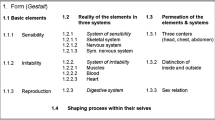Abstract
Hierarchical organization is an essential characteristic of living things. Although most biologists affirm the concept of living things as hierarchically organized structures, there are widespread differences of interpretation in the meaning of hierarchy and of how the concept of hierarchy applies to living things. One such basic difference involves the distinction between the concept of control hierarchy and classification hierarchy. It is suggested that control hierarchies are distinguished from classification hierarchies in that while the former involve authority relationships between levels, the latter do not. This is illustrated in an analysis of proposed hierarchies of replicators and interactors.
The analysis of levels of hierarchies and their relationships also brings up the part-whole problem. An authority relationship between levels implies that the whole has a determining influence on the parts that make up the whole, and that parts have no independent, meaningful existence apart from the whole. The concept of an authority relationship in a part-whole relationship introduces the question of the independence or sovereignty of the components of the subordinate levels in a hierarchically organized living thing. This problem is discussed along with an analysis of the rather novel theory of enkapsis proposed by H. Dooyeweerd, in which he distinguishes part-whole relationships from enkaptic relationships.
Similar content being viewed by others
References
Allen, T. F. H. and T. B. Starr: 1982, Hierarchy: Perspectives for Ecological Complexity, University of Chicago Press, Chicago.
Bertalanffy, L. von: 1952, The Problem of Life: An Evaluation of Modern Biological Thought, Watts & Co., London.
Bertalanffy, L. von: 1968, General System Theory: Foundations, Development, Applications, George Braziller, New York.
Buss, L. W.: 1987, The Evolution of Individuality, Princeton University Press, Princeton, New Jersey.
Campbell, D. T.: 1974, ‘“Downward Causation” in Hierarchically Organised Biological Systems’, in F. J. Ayala and T. Dobzhansky (eds.), Studies in the Philosophy of Biology, University of California Press, Berkeley, pp. 179–86.
Dooyeweerd, H.: 1957, A New Critique of Theoretical Thought, vol. III: The Structures of Individuality of Temporal Reality, Uitgeverij H. J. Paris, Amsterdam.
Eldredge, N.: 1985, Unfinished Synthesis: Biological Hierarchies and Modern Evolutionary Thought, Oxford University Press, Oxford.
Eldredge, N. and S. N. Salthe: 1984, ‘Hierarchy and Evolution’, in R. Dawkins and M. Ridley (eds.), Oxford Surveys in Evolutionary Biology, Vol. 1, Oxford University Press, Oxford, pp. 184–208.
Grene, M.: 1969, ‘Hierarchy: One Word, How Many Concepts?’, in L. L. Whyte, A. G. Wilson and D. Wilson (eds.), Hierarchical Structures, Elsevier, New York, pp. 56–58.
Grene, M.: 1987, ‘Hierarchies in Biology’, Amer. Scientist 75, 504–10.
Grene, M.: 1988, ‘Hierarchies and Behavior’, in G. Greenberg and E. Tobach (eds.) Evolution of Social Behavior and Integrative Levels, Lawrence Erlbaum Assoc., Hillsdale, New Jersey, pp. 3–17.
Grobstein, C.: 1962, ‘Levels and Ontogeny’, Amer. Scientist 50, 46–58.
Grobstein, C.: 1969, ‘Organizational Levels and Explanation’, J. Hist. Biol. 2, 199–206.
Grobstein, C.: 1973, ‘Hierarchical Order and Neogenesis’, in H. H. Pattee (ed.), Hierarchy Theory: The Challenges of Complex Systems, George Braziller, New York, pp. 31–47.
Hart, H.: 1984, Understanding Our World: An Integral Ontology, University Press of America, Lanham, Maryland.
Hull, D.: ‘Individuality and Selection’, Ann. Rev. Ecol. Syst. 11, 311–22.
Koestler, A.: 1969, ‘Beyond Atomism and Holism: The Concept of the Holon’, in A. Koestler and J. R. Smythies (eds.), Beyond Reductionism: New Perspectives in the Life Sciences, Macmillan, New York, pp. 193–232.
Laszlo, E.: 1972, Introduction to Systems Philosophy: Towards a New Paradigm of Contemporary Thought, Harper and Row, New York.
Mayr, E.: 1982, The Growth of Biological Thought, Harvard University Press, Cambridge.
Miller, J. G.: 1978, Living Systems, McGraw-Hill, New York.
Pattee, H. H.: 1970, ‘The Problem of Biological Hierarchy’, in C. H. Waddington (ed.), Towards a Theoretical Biology, Vol. 3, Edinburgh University Press, Edinburgh, pp. 117–36.
Pattee, H. H.: 1973a, ‘The Physical Basis and Origin of Hierarchical Control’, in H. H. Pattee (ed.), Hierarchy Theory: The Challenges of Complex Systems, George Braziller, New York, pp. 71–108.
Pattee, H. H.: 1973b, ‘Postscript: Unsolved Problems and Potential Applications of Hierarchy Theory’, in H. H. Pattee (ed.), Hierarchy Theory: The Challenges of Complex Systems, George Braziller, New York, pp. 129–56.
Polanyi, M.: 1968, ‘Life's Irreducible Structure’, Science 160, 1308–12.
Salthe, S. N.: 1985, Evolving Hierarchical Systems: Their Structure and Representation, Columbia University Press, New York.
Simon, H. A.: 1962, ‘The Architecture of Complexity’, Proc. Amer. Philos. Soc. 106, 467–82.
Vrba, E. S. and N. Eldredge: 1984, ‘Individuals, Hierarchies, and Processes: Towards a More Complete Evolutionary Theory’, Paleobiology 10, 146–71.
Weiss, P. A.: 1963, ‘The Cell as a Unit’, J. Theoret. Biol. 5, 389–97.
Weiss, P. A.: 1969, ‘The Living System: Determinism Stratified’, in A. Koestler and J. R. Smythies (eds.), Beyond Reductionism: New Perspectives in the Life Sciences, Macmillan, New York, pp. 3–55.
Weiss, P. A.: 1971, ‘The Basic Concept of Hierarchic Systems’, in P. A. Weiss (ed.), Hierarchically Organized Systems in Theory and Practice, Hafner Pub. Co., New York, pp. 1–43.
Weiss, P. A.: 1973, The Science of Life: The Living Systems — a System for Living, Futura Pub. Co., New York.
Woodger, J. H.: 1929 (reissued 1967), Biological Principles: a Critical Study, Routledge & Kegan Paul Ltd., New York.
Author information
Authors and Affiliations
Rights and permissions
About this article
Cite this article
Zylstra, U. Living things as hierarchically organized structures. Synthese 91, 111–133 (1992). https://doi.org/10.1007/BF00484972
Issue Date:
DOI: https://doi.org/10.1007/BF00484972




